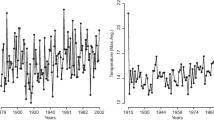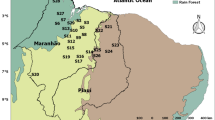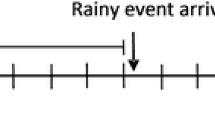Abstract
Rain precipitation in the last years has been very atypical in different regions of the world, possibly, due to climate changes. We analyze Standard Precipitation Index (SPI) measures (1, 3, 6 and 12-month timescales) for a large city in Brazil: Campinas located in the southeast region of Brazil, São Paulo State, ranging from January 01, 1947 to May 01, 2011. A Bayesian analysis of non-homogeneous Poisson processes in presence or not of change-points is developed using Markov Chain Monte Carlo methods in the data analysis. We consider a special class of models: the power law process. We also discuss some discrimination methods for the choice of the better model to be used for the rain precipitation data.



Similar content being viewed by others
References
Achcar JA, Bolfarine H (1989) Constant hazard against a change-point alternative: a Bayesian approach with censored data. Commun Stat Theory Methods 18(10):3801–3819. doi:10.1080/03610928908830124
Achcar JA, Fernández-Bremauntz AA, Rodrigues ER, Tzintzun G (2008) Estimating the number of ozone peaks in Mexico City using a non-homogeneous Poisson model. Environmetrics 19(5):469–485. doi:10.1002/env.890
Achcar JA, Loibel S (1998) Constant hazard models with a change-point: a Bayesian analysis using Markov chain Monte Carlo methods. Biom J 40:543–555
Achcar JA, Rodrigues ER, Paulino CD, Soares P (2010) Non-homogeneous Poisson models with a change-point: an application to ozone peaks in Mexico City. Environ Ecol Stat 17(4):521–541. doi:10.1007/s10651-009-0114-3
Barlow R, Hunter L (1960) Optimum preventive maintenance policies. Oper Res 8:90–100
Carlin BP, Gelfand AE, Smith AF (1992) Hierarchical Bayesian analysis of changepoint problems. Appl Stat 41(2):389–405
Chib S, Greenberg E (1995) Undestanding the Metropolis–Hastings algorithm. Am Stat 49(4):327–335
Chortaria C, Karavitis CA, Alexandris S (2010) Development of the spi drought index for greece using geo-statistical methods. In: Proceedings of BALWOIS 2010 international conference
Cid JER, Achcar JA (1999) Bayesian inference for nonhomogeneous Poisson processes in software reliability models assuming nonmonotonic intensity functions. Comput Stat Data Anal 32(2):147–159
Cox DR, Lewis PAW (1966) The statistical analysis of series of events. Methuen & Co., Ltd.; Wiley, London; New York
Crow LH (1974) Reliability analysis for complex systems. In: Proschan F, Serfling RJ (eds) Reliability and biometry. SIAM, Philadelphia, pp 379–410
Dey DK, Purkayastha S (1997) Bayesian approach to change point problems. Commun Stat Theory Methods 26(8):2035–2047. doi:10.1080/03610929708832030
Edwards DC (1997) Characteristics of 20th century drought in the united states at multiple time scales. Tech. rep., DTIC Document
Gelfand AE, Smith AFM (1990) Sampling-based approaches to calculating marginal densities. J Am Stat Assoc 85(410):398–409
Gelman A, Rubin DB (1992) Inference from iterative simulation using multiple sequences. Stat Sci 7(4):457–472
Ghysels E (1996) Stochastic volatility. Statistical methods on finance. Springer, New York
Guttman NB (1994) On the sensitivity of sample l moments to sample size. J Clim 7(6):1026–1029
Hayes MJ, Svoboda MD, Wilhite DA, Vanyarkho OV (1999) Monitoring the 1996 drought using the standardized precipitation index. Bull Am Meteorol Soc 80(3):429–438
Karavitis CA (1998) Drought and urban water supplies: the case of metropolitan athens. Water Policy 1(5):505–524
Karavitis CA (1999) Decision support systems for drought management strategies in metropolitan athens. Water Int 24(1):10–21
Karavitis CA, Alexandris S, Tsesmelis DE, Athanasopoulos G (2011) Application of the standardized precipitation index (spi) in Greece. Water 3(3):787–805
Kim S, Shephard N, Chib S (1998) Stochastic volatility: likelihood inference and comparison with arch models. Rev Econ Stud 65(3):361–393
Kuo L, Yang TY (1996) Bayesian computation for nonhomogeneous Poisson processes in software reliability. J Am Stat Assoc 91(434):763–773
Lana X, Serra C, Burgueño A (2001) Patterns of monthly rainfall shortage and excess in terms of the standardized precipitation index for catalonia (ne spain). Int J Climatol 21(13):1669–1691
Livada I, Assimakopoulos V (2007) Spatial and temporal analysis of drought in Greece using the standardized precipitation index (spi). Theor Appl Climatol 89(3–4):143–153
Matthews DE, Farewell VT (1982) On testing for a constant hazard against a change-point alternative. Biometrics 38(2):463–468
McKee TB, Doesken NJ, Kleist J (1995) Drought monitoring with multiple time scales. In: Ninth conference on applied climatology. American Meteorological Society, Boston
McKee TB, Doesken NJ, Kleist J et al (1993) The relationship of drought frequency and duration to time scales. In: Proceedings of the 8th conference on applied climatology, vol 17. American Meteorological Society, Boston, MA, USA, pp 179–183
Meyer R, Yu J (2000) Bugs for a Bayesian analysis of stochastic volatility models. Econ J 3(2):198–215
Musa JD, Iannino A, Okumoto K (1987) Software reliability: measurement, prediction, application. McGraw-Hill Inc, New York
Musa JD, Okumoto K (1984) A logarithmic poisson execution time model for software reliability measurement. In: Proceedings of the 7th international conference on software engineering, IEEE Press, pp 230–238
Palmer WC (1965) Meteorological drought, weather bureau research paper no. 45. US Department of Commerce, Washington
Pievatolo A, Ruggeri F (2004) Bayesian reliability analysis of complex repairable systems. Appl Stoch Model Bus Ind 20(3):253–264. doi:10.1002/asmb.522
R Core Team(2015) R: A language and environment for statistical computing. R Foundation for Statistical Computing, Vienna, Austria. https://www.R-project.org/
Raftery A, Akman V (1986) Bayesian analysis of a Poisson process with a change-point. Biometrika 71(1):85–89
Ramsay JO, Silverman BW (2006) Functional data analysis. Wiley, New York
Ruggeri F, Sivaganesan S (2005) On modeling change points in non-homogeneous Poisson processes. Stat Inference Stoch Process 8(3):311–329
Smith AFM, Roberts GO (1993) Bayesian computation via the Gibbs sampler and related Markov chain Monte Carlo methods. J R Stat Soc Ser B Methodol 55(1): 3–23. http://links.jstor.org/sici?sici=0035-9246(1993)55:1<3:BCVTGS>2.0.CO;2-#&origin=MSN
Sönmez FK, Koemuescue AU, Erkan A, Turgu E (2005) An analysis of spatial and temporal dimension of drought vulnerability in Turkey using the standardized precipitation index. Nat Hazards 35(2):243–264
Spiegelhalter DJ, Best NG, Carlin BP, Van Der Linde A (2002) Bayesian measures of model complexity and fit. J R Stat Soc Ser B Stat Methodol 64(4):583–639
Su YS, Yajima M (2015) R2jags: Using R to Run ’JAGS’ . R package version 0.5-6. http://CRAN.R-project.org/package=R2jags
Acknowledgments
The authors are very grateful to the Editor and a referee for their helpful and useful comments that improved the manuscript. The first author was partially supported by CNPq-Brazil.
Author information
Authors and Affiliations
Corresponding author
Additional information
Handling Editor Bryan F. J. Manly.
Rights and permissions
About this article
Cite this article
Achcar, J.A., Coelho-Barros, E.A. & de Souza, R.M. Use of non-homogeneous Poisson process (NHPP) in presence of change-points to analyze drought periods: a case study in Brazil. Environ Ecol Stat 23, 405–419 (2016). https://doi.org/10.1007/s10651-016-0345-z
Received:
Revised:
Published:
Issue Date:
DOI: https://doi.org/10.1007/s10651-016-0345-z




